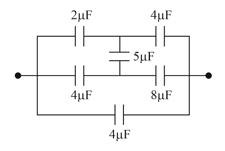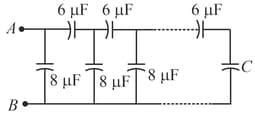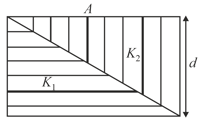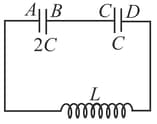Find the equivalent capacitance of the combinations shown in the figure between the indicated points.



Important Questions on Capacitance
A finite ladder circuit is constructed by connecting several sections of capacitor combinations as shown in the figure. Circuit is terminated by a capacitor of capacitance . Find the value of , such that the equivalent capacitance of the ladder between the points and becomes independent of the number of sections in between?

The capacitance of a parallel plate capacitor with plate area and separation is , is . The space between the plates is filled with two wedges of dielectric constant and respectively (figure). Find the capacitance of the resulting capacitor.

A conducting sphere of radius is attached to an insulating handle. Another conducting sphere of radius R is mounted on an insulating stand. is initially uncharged. is given a charge , brought into contact with and removed. is then recharged such that the charge on it is again & it is again brought into contact with & removed. This procedure is repeated times
(a) Find the electrostatic energy of after n such contacts with .
(b) What is the limiting value of this energy as ?
Two capacitors of capacitances are connected in series with an inductor of inductance L. Initially capacitors have charges such that Initial current in the circuit is zero. Find The maximum current that will flow in the circuit and the potential difference across each capacitor at that instant.

